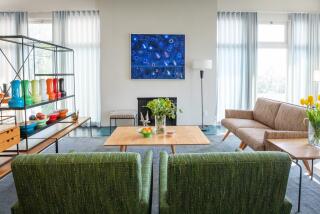Different Strokes : For a New Look, Try Paint, a Little Glaze, Some Combs and Sponges--Even Plastic Bags
- Share via
PAINT. IT CAN TRANSFORM even the most ordinary room into something timeless (think of the Sistine Chapel). Especially in the ‘90s, there is more to colorizing a room than applying a couple of coats with roller and brush. Painted walls now are multicolored and multi-layered--using applicators that range from sponges and rags to bags and combs--to create a rich variety of textured surfaces. And seldom is a new-style wall complete without a glaze--an artfully applied topping that adds luminosity and depth.
Retro interiors and furnishings are the hottest look in interior design, and glazes instantly insinuate age and add patina to any interior. When designer Ron Meyers decorated the Atlas Bar and Grill Restaurant in the old Wiltern Theater complex, he glazed its white stucco walls with shades of ocher to warm its Olympian atmosphere.
Then, inspired by a photo of a room in an old French house, Meyers painted a client’s bedroom an ocher-based yellow with counterpoints of blue and added moldings to walls and ceiling. To bathe the room in a golden hue, he gave the walls four coats of glazes of different tints, which he applied unevenly to capture the light in a variety of tones. The result, Meyers says, leaves him breathless. “A white, boxy room awash with an ocher-yellow glaze makes the air itself glow,” he says.
Other painting techniques, which can be used with ecologically correct water-based paints, create unusual looks and atmospheres:
--Stippling: The paint, or glaze, is brushed on and then distressed with the tip a of soft bristled brush. The result is a highly textured wall.
--Ragging: Bundles of soft rags are pressed into wet paint, producing a softer look.
--Sponging: A sponge is rubbed on wet paint, creating a mottled texture.
--Dragging: Bristles are drawn through wet paint, deliberately leaving brush marks.
Though glazing is a traditional technique, its comeback is by no means anachronistic. In a revision of ragging, clothing designer Michael Anderson invented “bagging.” He simply took a plastic bag--”the kind they give you in the market”--to the walls of his client’s Art Deco-inspired sitting room. As he applied a green glaze over a pink base coat, “we bagged it,” he says, by rumpling up a bag and pressing it into the wet glaze to create a mottled pattern and give the walls a three-dimensional effect. Flushed with success, Anderson devised an applicator from a floor-adhesive spreader to create a chair-rail pattern in the office. He notched the spreader’s blade to get a comb effect.
Occasionally, the best painted walls are those not painted at all. Production designer Richard Sherman bought a house once owned by the eccentric photographer Baron de Meyer, who, upon his wife’s death, entered a “blue period,” complete with blue walls. Sherman intended to paint his kitchen white, but when he started to clean the cabinets, the blue rubbed off just enough to create an Old World effect. So he just “409-ed” them and stopped. The simplest technique of all.


